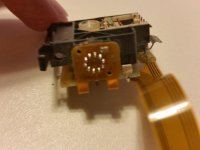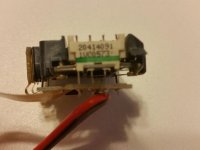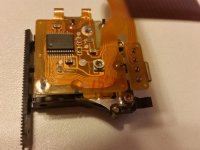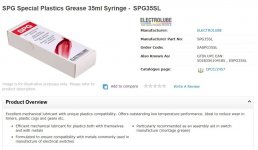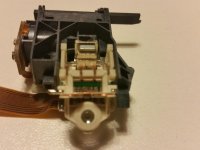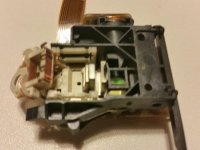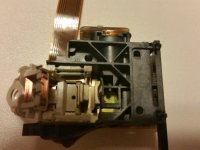I did as I planned. First I took out the pickup. You have to take out the big white gearwheel using some force. To release the chrome rail you have to pull out the white clamp, The ending switch has not to be unscrewed but it's a chance to clean it as well.
To get into contacts on the pickup the metal shield has to be removed. It is soldered in two places. To take it out I used desoldering wick. After removal I saw preamplifier chip made by Philips with following description TZA1022 TS; V7247 01;Dn 602092. I resoldered all joints by applying some fluid flux and touching with soldering iron tip. My iron has ca. 220 degrees Celsius so it shouldn't damage the electronics. The chip connections are ultra small so I just crossed them with hot iron. Then I cleaned everything with alcohol and assembled back and put the VAM1250 into Marantz DR4050. It started playing immediately !
I have general question: it is not written on a pickup that it is VAM 1250. In my pickup the description is 1VC0573 does it mean anything ? How do you know having just a pickup to what VAM or CDM it belongs to ? Just from description on a box ?
To get into contacts on the pickup the metal shield has to be removed. It is soldered in two places. To take it out I used desoldering wick. After removal I saw preamplifier chip made by Philips with following description TZA1022 TS; V7247 01;Dn 602092. I resoldered all joints by applying some fluid flux and touching with soldering iron tip. My iron has ca. 220 degrees Celsius so it shouldn't damage the electronics. The chip connections are ultra small so I just crossed them with hot iron. Then I cleaned everything with alcohol and assembled back and put the VAM1250 into Marantz DR4050. It started playing immediately !
I have general question: it is not written on a pickup that it is VAM 1250. In my pickup the description is 1VC0573 does it mean anything ? How do you know having just a pickup to what VAM or CDM it belongs to ? Just from description on a box ?
Attachments
I would like to come back to post #1. You mentioned about cleaning and lubricating of the pickup.
a) cleaning - what do you use ? I was reading plenty of posts and came to conclusion that only demineralized water should be used as isoporopanolol and other solvents (windows washer) may destroy an anti glare coating on the lens. Of course water has to be then wiped out with a cloth (microfibre or leather used for glasses). You have to watch as water may go inside focusing wires so it's better to wait some time to be sure it dried out.
b) lubricating - Philips recommends Tribol by Castrol but it is supplied in really big containers. There are three sorts of lubricants (what I noticed)
- silicone grease which is not good to electrical connections
- white lithium grease - the best (?)
- grease with molibdenum disulphide - also not good, not sure why.
a) cleaning - what do you use ? I was reading plenty of posts and came to conclusion that only demineralized water should be used as isoporopanolol and other solvents (windows washer) may destroy an anti glare coating on the lens. Of course water has to be then wiped out with a cloth (microfibre or leather used for glasses). You have to watch as water may go inside focusing wires so it's better to wait some time to be sure it dried out.
b) lubricating - Philips recommends Tribol by Castrol but it is supplied in really big containers. There are three sorts of lubricants (what I noticed)
- silicone grease which is not good to electrical connections
- white lithium grease - the best (?)
- grease with molibdenum disulphide - also not good, not sure why.
Yes, pure isopropyl isn't to be recommended.
Having exhausted my special Sony lens cleaning fluid I now make my own which consists of pure water and isopropyl alcohol in an approximate 70:30 ratio. I guess I make around 10ml at a time whenever I do this, just enough to fill a very small bottle.
I actually use steam from a kettle blowing onto an freezer ice pack to get the water.
To that solution I add one very small drop of ordinary detergent (washing up liquid).
And that's it
The lubricant I prefer is one that is for plastics/metal use such as this:
http://cpc.farnell.com/electrolube/...e&ddkey=http:en-CPC/CPC_United_Kingdom/search
Having exhausted my special Sony lens cleaning fluid I now make my own which consists of pure water and isopropyl alcohol in an approximate 70:30 ratio. I guess I make around 10ml at a time whenever I do this, just enough to fill a very small bottle.
I actually use steam from a kettle blowing onto an freezer ice pack to get the water.
To that solution I add one very small drop of ordinary detergent (washing up liquid).
And that's it
The lubricant I prefer is one that is for plastics/metal use such as this:
http://cpc.farnell.com/electrolube/...e&ddkey=http:en-CPC/CPC_United_Kingdom/search
Attachments
Happy New Year !!!
Having a chance to buy an unused CDM 12.6 for equivalent of 5 pounds I decided to use it for scientific purposes. I wondered if it is possible to take out the lens assembly in order to have acces to bottom side of the lens as well as to the prism and "diode cave". The lens assembly is hanging on four "hands" made of very thin plastic. There are 2 hands on each side connected vertically and clamped to the lens assembly. You may lift the lens assembly up to a certain point and that's it. I have used toothpick as a wedge and was able to unclamp the assembly and turn it upside down. You have to watch of course on focusing wires as they are extra thin but having time and doing everything carefully there's no big risk for damage. Please have a look on pictures !
Having a chance to buy an unused CDM 12.6 for equivalent of 5 pounds I decided to use it for scientific purposes. I wondered if it is possible to take out the lens assembly in order to have acces to bottom side of the lens as well as to the prism and "diode cave". The lens assembly is hanging on four "hands" made of very thin plastic. There are 2 hands on each side connected vertically and clamped to the lens assembly. You may lift the lens assembly up to a certain point and that's it. I have used toothpick as a wedge and was able to unclamp the assembly and turn it upside down. You have to watch of course on focusing wires as they are extra thin but having time and doing everything carefully there's no big risk for damage. Please have a look on pictures !
Attachments
I will test it in the nearest opportunity. My idea was to know what to do in case of a need for cleaning the pickup which is actually playing. As to LD cracking - perhaps for curiosity, but on this topic I can see how the LD looks like. The original diode is on e-bay for ca $36 plus mailing. Noone sells it in Poland. So Iwill rather wait for a bargain.
I was thinking along the lines of comparing the RF before and after cleaning (to see if it increased) and also with the LD whether it can be,
a/ Removed and refitted and still work OK (same RF output). This would be leaving the original glue in place.
b/ As above but cleaning the glue off and seeing then seeing how critical the diode placement/rotation is.
a/ Removed and refitted and still work OK (same RF output). This would be leaving the original glue in place.
b/ As above but cleaning the glue off and seeing then seeing how critical the diode placement/rotation is.
Understood. But looking on diode shape as seen on a picture in post #8 the diode shape is rectangular so I would create a rectangular "hole" in the diode cave to not allow it to turn. If not please see 2 grooves on diode housing - they are also to make sure diode is on the right place.
Besides I don't have any special instruments to test this, This is like in the joke about Napoleon - "firstly we don't have cannons"
One additional question: what do you use to lubricate the hall motor shaft ?
Philips recommends Mobil Oil SHC 629 ... but it is supplied in 20l containers.
Besides I don't have any special instruments to test this, This is like in the joke about Napoleon - "firstly we don't have cannons"
One additional question: what do you use to lubricate the hall motor shaft ?
Philips recommends Mobil Oil SHC 629 ... but it is supplied in 20l containers.
I think the diodes like in post #8 would rotate freely in their locating hole. No ? What I was getting at was whether the alignment is super critical... 100th mm making big differences, or is it pretty non critical.
I don't know on that.
Oils... hmmm... I have some old sintered bearing oil from the days of lubrication kits for VCR's, but those days are long gone. I wouldn't stress over trying to get a special oil. A single drop of fresh engine oil would probably be as good as anything. Its not to thin and wont disappear in a hurry.
I don't know on that.
Oils... hmmm... I have some old sintered bearing oil from the days of lubrication kits for VCR's, but those days are long gone. I wouldn't stress over trying to get a special oil. A single drop of fresh engine oil would probably be as good as anything. Its not to thin and wont disappear in a hurry.
As to the diode, please remember that it's "legs" must go to holes in PCB (or PCFilm) so if you turn it you will not mount it.
I have another idea related to laser pickup cleaning: dissolving vs cleaning. What if I dip the pickup in a liquid as described in post #44? I will dissolve fat covering lenses, prism and diode. I will also dissolve grease on shaft hole and toothed rack ... but I can replace it afterwards. Of course after some minutes "bath" I would let it dry say 24 hours and then put back to the player.
What do you think ?
I have another idea related to laser pickup cleaning: dissolving vs cleaning. What if I dip the pickup in a liquid as described in post #44? I will dissolve fat covering lenses, prism and diode. I will also dissolve grease on shaft hole and toothed rack ... but I can replace it afterwards. Of course after some minutes "bath" I would let it dry say 24 hours and then put back to the player.
What do you think ?
I once did clean a pickup by blasting it internally with iso but I had nothing to lose, the player (a first generation Toshiba) had been in a shop flood and was badly contaminated.
I did get it to work in the end but it was flaky.
These are unknowns and methods of last resort.
The laser diode... when I talk of physical alignment of the diode I'm meaning difference in position less than the thickness of a piece of paper and whether internal optics such as prisms and turning mirrors are factory aligned after the diode has been placed, or does it not matter. That's what I don't know.
If you've ever done a diffraction grating adjustment on those pickups that have that as an alignment then you will know just how critical we are talking.
I did get it to work in the end but it was flaky.
These are unknowns and methods of last resort.
The laser diode... when I talk of physical alignment of the diode I'm meaning difference in position less than the thickness of a piece of paper and whether internal optics such as prisms and turning mirrors are factory aligned after the diode has been placed, or does it not matter. That's what I don't know.
If you've ever done a diffraction grating adjustment on those pickups that have that as an alignment then you will know just how critical we are talking.
No idea on that although my first thought would be that the reflectivity could be out of spec or low.
Servo electronics have vastly improved over first generation players... its the old story... think of when VHS hit the markets. The mechanics were over engineered and general solid substantial pieces of engineering. They had to be because the servos and signal processing couldn't deal with fluctuating errors caused by mechanical issues. Later decks were like pressed baked bean cans, but the electronics were superb and could cope much better.
Servo electronics have vastly improved over first generation players... its the old story... think of when VHS hit the markets. The mechanics were over engineered and general solid substantial pieces of engineering. They had to be because the servos and signal processing couldn't deal with fluctuating errors caused by mechanical issues. Later decks were like pressed baked bean cans, but the electronics were superb and could cope much better.
The production was carried out according to the "RED BOOK" standard or not? - go toI have noticed that some legal but not branded CDs are completely not recognized by Philips pickups while cheap chinese DVDs playing them normally. Why ? Are beams in newer pickups thinner ? Or perhaps peripheral ICs are more capable.
What Is A Red Book CD?
I have done this long time ago using a non oil cleaning spray with success.As to the diode, please remember that it's "legs" must go to holes in PCB (or PCFilm) so if you turn it you will not mount it.
I have another idea related to laser pickup cleaning: dissolving vs cleaning. What if I dip the pickup in a liquid as described in post #44? I will dissolve fat covering lenses, prism and diode. I will also dissolve grease on shaft hole and toothed rack ... but I can replace it afterwards. Of course after some minutes "bath" I would let it dry say 24 hours and then put back to the player.
What do you think ?
Last edited:
check out post #37 under
https://www.diyaudio.com/community/...ransport-compatible-replacement.156227/page-2
https://www.diyaudio.com/community/...ransport-compatible-replacement.156227/page-2
On cleaning lenses.
I had to clean the lens of my Pentax 105SDP 4" astrophotography telescope when I bought it used. Just the outside surfaces of the front and back doublet clusters inside the scope. I used Baader cleaner and the way you clean is dragging the meniscus across the lens centre to outside but not let the cotton but touch the lens. Additionally I used a dehumidifier air filter in the room for 24 hours before hand to reduce moisture and to lower the amount of dust.
Not a short squeaky-bum moment .. if I remember it took three hours!
Naturally that was a serious need of a clean (it looks like a fungus inside - all removed and clean as a whistle). Typically it's only advised todo that in emergencies. I suspect laser lenses are similar - a simple rinse is preferred method. For scopes with mirrors they don't touch the mirror and leave the dirt on or you'll remove the vacuum deposited coating!
I had to clean the lens of my Pentax 105SDP 4" astrophotography telescope when I bought it used. Just the outside surfaces of the front and back doublet clusters inside the scope. I used Baader cleaner and the way you clean is dragging the meniscus across the lens centre to outside but not let the cotton but touch the lens. Additionally I used a dehumidifier air filter in the room for 24 hours before hand to reduce moisture and to lower the amount of dust.
Not a short squeaky-bum moment .. if I remember it took three hours!
Naturally that was a serious need of a clean (it looks like a fungus inside - all removed and clean as a whistle). Typically it's only advised todo that in emergencies. I suspect laser lenses are similar - a simple rinse is preferred method. For scopes with mirrors they don't touch the mirror and leave the dirt on or you'll remove the vacuum deposited coating!
- Home
- Source & Line
- Digital Source
- Stripdown/Clean of CDM12.4
